Ping Pong Tutorial
Scope
This tutorial describes how to create a simple hierarchical actor system of actors communicating via ports and bindings. Additionally you will use the Timing Service from the eTrice model library. This tutorial works for all target languages. Refer to the "Getting Started" pages for more information about creating an initial eTrice project for a specific target language.
For the Ping Pong scenario we want to create a model with a sender and a receiver of a message. The receiver has to wait for the ping message from the sender, wait for a second and respond with a pong message.
The resulting Message Sequence Chart (MSC) at the end of this tutorial should look like this:
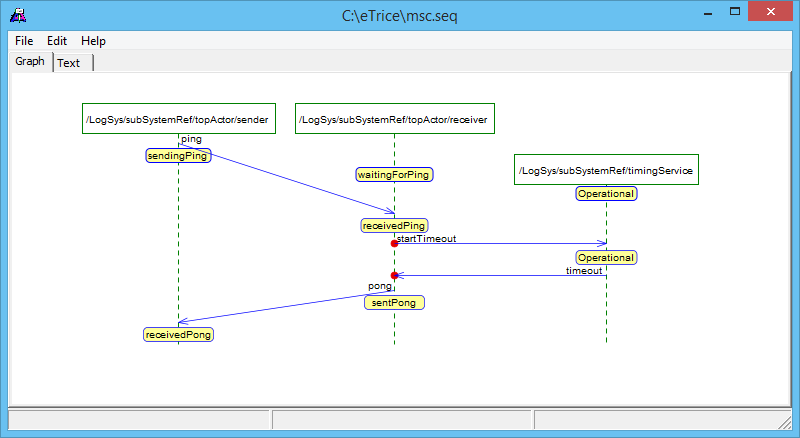
We will take this MSC as specification for the desired behavior.
Create the structure
We start by opening the TemplateModel.room from the template project as presented in Getting Started. As described previously topActor is currently the only active actor. Furthermore the model provides a building kit for this tutorial, consisting of
-
ProtocolClass PingPongProtocol: Defining the incoming message ping and outgoing pong according the specification
-
ActorClass Receiver: Defining a (regular) Port of type PingPongProtocol, which receives the incoming messages and sends the outgoing message. Additionally it has a reference to the TimingService.
-
ActorClass Sender: Defining the conjugated Port of type PingPongProtocol, which handles the messages vice-versa
ProtocolClass PingPongProtocol {
incoming {
Message ping()
}
outgoing {
Message pong()
}
}
ActorClass Receiver {
Interface {
Port recvPort: PingPongProtocol
}
Structure {
external Port recvPort
SAP timingService: PTimer
}
// ...
}
ActorClass Sender {
Interface {
conjugated Port sendPort:
PingPongProtocol
}
Structure {
external Port sendPort
}
// ...
}
The naming Sender Receiver is based on the first message exchange. Sender is the first actor that sends a message (ping) and Receiver is the first actor to receive this message.
Remaining tasks:
-
creating the hierarchical actor structure by using classes the Sender and Receiver
-
establish port binding
-
define the behavior of both actors
-
use the TimingService
-
generate and run application, then verify resulting MSC
We are going to create the hierarchical actor structure and TopActor will serve as a pure container actor. Thus its current state machine is obsolete, we can ignore or delete it.
We continue to add the actors graphically and open the structure diagram of TopActor by right-click in the Outline View on TopActor -> Edit Structure.

Drag and Drop an ActorRef from the Palette within the borders and name the new actor reference sender and set the type to ActorClass Sender. Repeat the step for the receiver of ActorClass type Receiver.
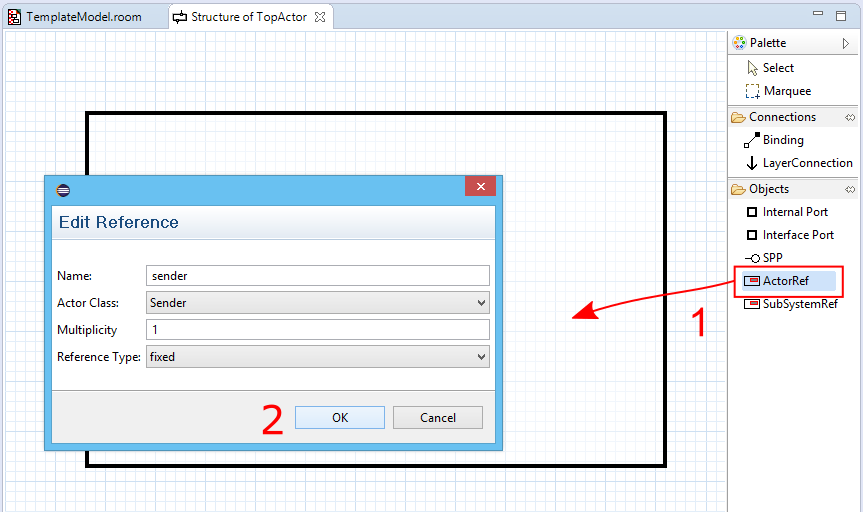
Finally we connect the ports of both actors using the Binding tool in the Palette. Drag a connection between the two ports to establish a Binding.
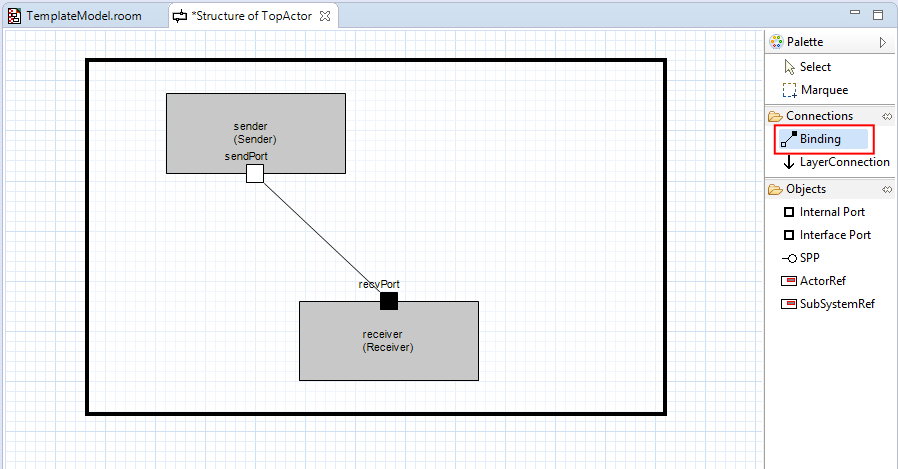
Implement the Behavior
We will implement two finite state machines (FSMs) to define the event driven behavior of the actor classes Sender and Receiver.
Before you start with the implementation, have a look at the MSC with the specification of the behavior at the beginning of this page.
Lets start with the Sender. In the structure diagram of TopActor right click on sender and select Open Ref Behavior.
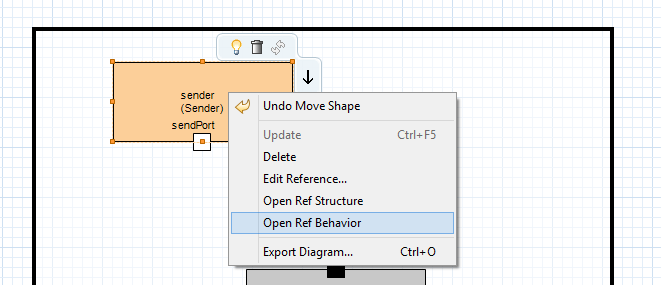
According to our specification:
Sender initially should send the message ping and then assume a state named sendingPing. After receiving the message pong it should switch to a state named receivedPong.
Drag and Drop the Initial Point and a State into the diagram. The latter causes the opening of the dialog Edit State, in which we type the name sendingPing
and specify the entry code sendPort.ping();.
Note that the content assist is activated by pressing CTRL+Space.
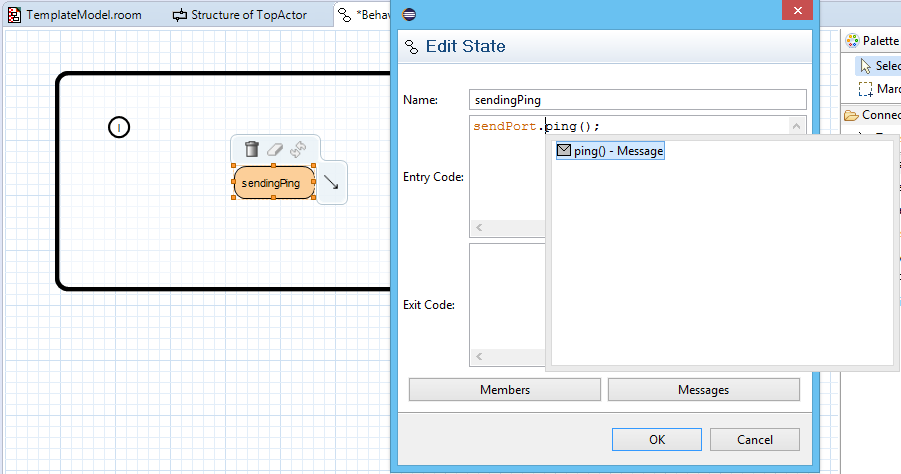
In the same manner we create a second State named receivedPong but without any action.
Use the Transition tool to draw the initial transition to sendingPing. The dialog Edit Transition will open and we just click OK as no action is required. Note that initial transitions do not have any trigger events.
Again draw a transition from sendingPing to receivedPong. In the dialog for this transition we set the trigger event to message pong of port sendPort in the top right corner.
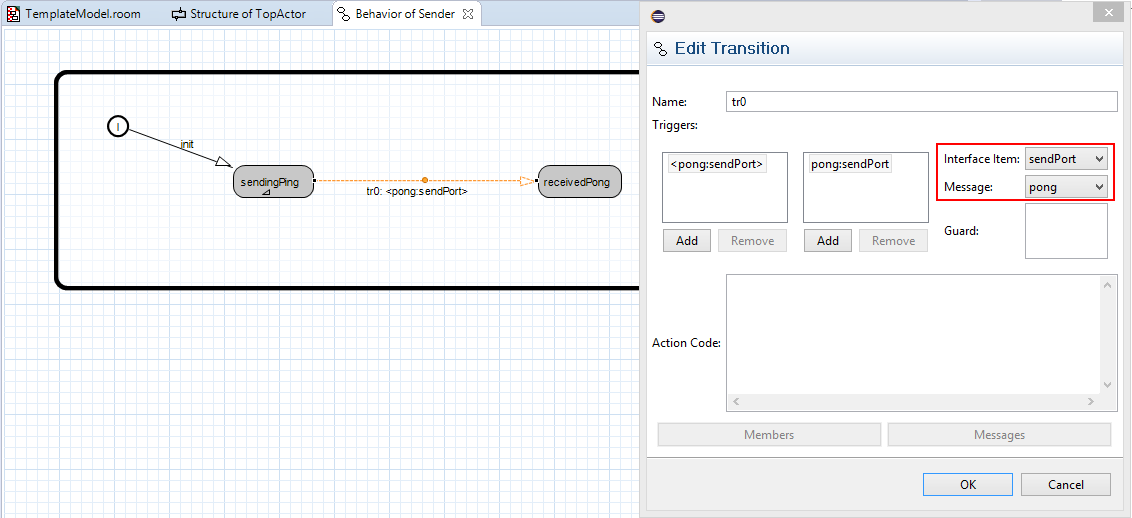
At this point the behavior of Sender is complete and should look like this:

Now we can save the behavior diagram. This will also synchronize the Behavior content of the ActorClass in TemplateModel.room.
We turn our attention to actor Receiver and open its state machine diagram.
According to the specification:
Receiver initially should wait for the message ping. After a short time the message pong should be sent back.
We create the states waitingForPing, receivedPing and sentPong plus the initial state.
Then we draw a transition from the initial state to the state waitingForPing.
Next we draw a transition from waitingForPing to receivedPing and select as trigger event the message ping of port recvPort.
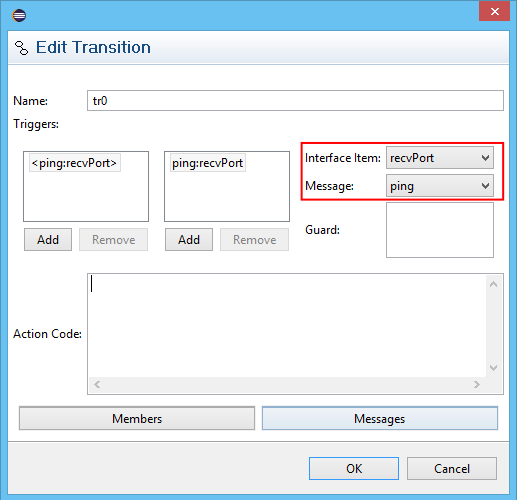
In the entry code of the state receivedPing we start the timeout by sending the message startTimeout(500) (time unit is ms) to the timingService port:
timingService.startTimeout(500);
We draw a transition from receivedPing to sentPong. The trigger event is the response message timeout of the timing service.
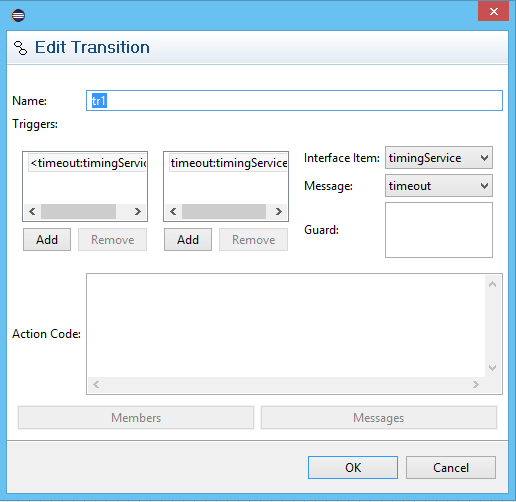
In the entry code of the state sentPong we send the message pong back to the Sender: recvPort.pong();
Now the behavior of Receiver is complete. It should look like this:
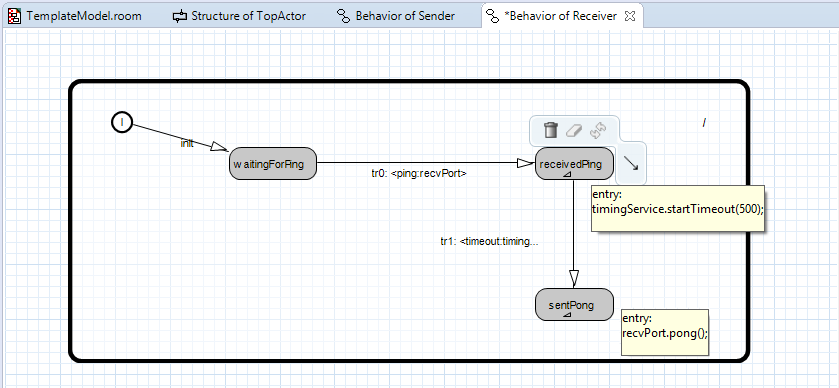
Save the behavior diagram.
The PingPong model is now done. You can generate, compile and run it as described in the Getting Started page. The generated MSC in folder log should show the same MSC we used to specify the behavior at the beginning of this tutorial.

Summary
Within this tutorial you have learned how to create a FSM with transitions triggered by incoming messages. You have used entry code to send messages and have used the timing service from the model library. You are now familiar with the basic features of eTrice. Further tutorials and examples will assume that the reader is already familiar with this basic knowledge.